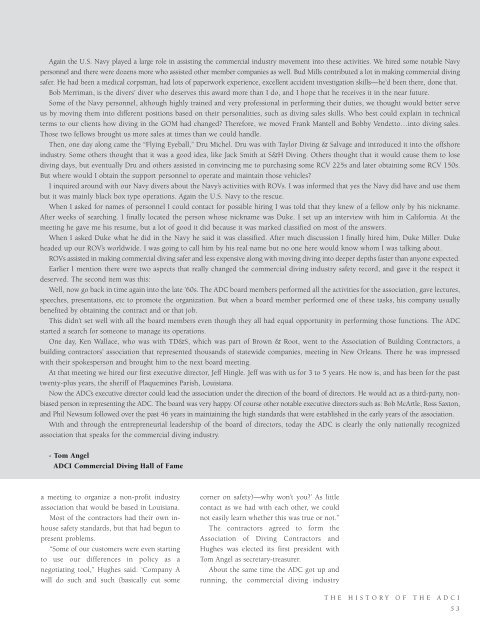Working Underwater: The Story of the Commercial Diving Industry
An illustrated history of the commercial diving industry paired with the histories of companies that have helped shape the industry.
An illustrated history of the commercial diving industry paired with the histories of companies that have helped shape the industry.
You also want an ePaper? Increase the reach of your titles
YUMPU automatically turns print PDFs into web optimized ePapers that Google loves.
Again <strong>the</strong> U.S. Navy played a large role in assisting <strong>the</strong> commercial industry movement into <strong>the</strong>se activities. We hired some notable Navy<br />
personnel and <strong>the</strong>re were dozens more who assisted o<strong>the</strong>r member companies as well. Bud Mills contributed a lot in making commercial diving<br />
safer. He had been a medical corpsman, had lots <strong>of</strong> paperwork experience, excellent accident investigation skills—he’d been <strong>the</strong>re, done that.<br />
Bob Merriman, is <strong>the</strong> divers’ diver who deserves this award more than I do, and I hope that he receives it in <strong>the</strong> near future.<br />
Some <strong>of</strong> <strong>the</strong> Navy personnel, although highly trained and very pr<strong>of</strong>essional in performing <strong>the</strong>ir duties, we thought would better serve<br />
us by moving <strong>the</strong>m into different positions based on <strong>the</strong>ir personalities, such as diving sales skills. Who best could explain in technical<br />
terms to our clients how diving in <strong>the</strong> GOM had changed? <strong>The</strong>refore, we moved Frank Mantell and Bobby Vendetto…into diving sales.<br />
Those two fellows brought us more sales at times than we could handle.<br />
<strong>The</strong>n, one day along came <strong>the</strong> “Flying Eyeball,” Dru Michel. Dru was with Taylor <strong>Diving</strong> & Salvage and introduced it into <strong>the</strong> <strong>of</strong>fshore<br />
industry. Some o<strong>the</strong>rs thought that it was a good idea, like Jack Smith at S&H <strong>Diving</strong>. O<strong>the</strong>rs thought that it would cause <strong>the</strong>m to lose<br />
diving days, but eventually Dru and o<strong>the</strong>rs assisted in convincing me to purchasing some RCV 225s and later obtaining some RCV 150s.<br />
But where would I obtain <strong>the</strong> support personnel to operate and maintain those vehicles?<br />
I inquired around with our Navy divers about <strong>the</strong> Navy’s activities with ROVs. I was informed that yes <strong>the</strong> Navy did have and use <strong>the</strong>m<br />
but it was mainly black box type operations. Again <strong>the</strong> U.S. Navy to <strong>the</strong> rescue.<br />
When I asked for names <strong>of</strong> personnel I could contact for possible hiring I was told that <strong>the</strong>y knew <strong>of</strong> a fellow only by his nickname.<br />
After weeks <strong>of</strong> searching. I finally located <strong>the</strong> person whose nickname was Duke. I set up an interview with him in California. At <strong>the</strong><br />
meeting he gave me his resume, but a lot <strong>of</strong> good it did because it was marked classified on most <strong>of</strong> <strong>the</strong> answers.<br />
When I asked Duke what he did in <strong>the</strong> Navy he said it was classified. After much discussion I finally hired him, Duke Miller. Duke<br />
headed up our ROV’s worldwide. I was going to call him by his real name but no one here would know whom I was talking about.<br />
ROVs assisted in making commercial diving safer and less expensive along with moving diving into deeper depths faster than anyone expected.<br />
Earlier I mention <strong>the</strong>re were two aspects that really changed <strong>the</strong> commercial diving industry safety record, and gave it <strong>the</strong> respect it<br />
deserved. <strong>The</strong> second item was this:<br />
Well, now go back in time again into <strong>the</strong> late ’60s. <strong>The</strong> ADC board members performed all <strong>the</strong> activities for <strong>the</strong> association, gave lectures,<br />
speeches, presentations, etc to promote <strong>the</strong> organization. But when a board member performed one <strong>of</strong> <strong>the</strong>se tasks, his company usually<br />
benefited by obtaining <strong>the</strong> contract and or that job.<br />
This didn’t set well with all <strong>the</strong> board members even though <strong>the</strong>y all had equal opportunity in performing those functions. <strong>The</strong> ADC<br />
started a search for someone to manage its operations.<br />
One day, Ken Wallace, who was with TD&S, which was part <strong>of</strong> Brown & Root, went to <strong>the</strong> Association <strong>of</strong> Building Contractors, a<br />
building contractors’ association that represented thousands <strong>of</strong> statewide companies, meeting in New Orleans. <strong>The</strong>re he was impressed<br />
with <strong>the</strong>ir spokesperson and brought him to <strong>the</strong> next board meeting.<br />
At that meeting we hired our first executive director, Jeff Hingle. Jeff was with us for 3 to 5 years. He now is, and has been for <strong>the</strong> past<br />
twenty-plus years, <strong>the</strong> sheriff <strong>of</strong> Plaquemines Parish, Louisiana.<br />
Now <strong>the</strong> ADC’s executive director could lead <strong>the</strong> association under <strong>the</strong> direction <strong>of</strong> <strong>the</strong> board <strong>of</strong> directors. He would act as a third-party, nonbiased<br />
person in representing <strong>the</strong> ADC. <strong>The</strong> board was very happy. Of course o<strong>the</strong>r notable executive directors such as: Bob McArtle, Ross Saxton,<br />
and Phil Newsum followed over <strong>the</strong> past 46 years in maintaining <strong>the</strong> high standards that were established in <strong>the</strong> early years <strong>of</strong> <strong>the</strong> association.<br />
With and through <strong>the</strong> entrepreneurial leadership <strong>of</strong> <strong>the</strong> board <strong>of</strong> directors, today <strong>the</strong> ADC is clearly <strong>the</strong> only nationally recognized<br />
association that speaks for <strong>the</strong> commercial diving industry.<br />
- Tom Angel<br />
ADCI <strong>Commercial</strong> <strong>Diving</strong> Hall <strong>of</strong> Fame<br />
a meeting to organize a non-pr<strong>of</strong>it industry<br />
association that would be based in Louisiana.<br />
Most <strong>of</strong> <strong>the</strong> contractors had <strong>the</strong>ir own inhouse<br />
safety standards, but that had begun to<br />
present problems.<br />
“Some <strong>of</strong> our customers were even starting<br />
to use our differences in policy as a<br />
negotiating tool,” Hughes said. ‘Company A<br />
will do such and such (basically cut some<br />
corner on safety)—why won’t you?’ As little<br />
contact as we had with each o<strong>the</strong>r, we could<br />
not easily learn whe<strong>the</strong>r this was true or not.”<br />
<strong>The</strong> contractors agreed to form <strong>the</strong><br />
Association <strong>of</strong> <strong>Diving</strong> Contractors and<br />
Hughes was elected its first president with<br />
Tom Angel as secretary-treasurer.<br />
About <strong>the</strong> same time <strong>the</strong> ADC got up and<br />
running, <strong>the</strong> commercial diving industry<br />
THE HISTORY OF THE ADCI<br />
53
















